You are here
Wwii Rare 5th Army Hq Field Printed Route Numbering Invasion Map Central Italy
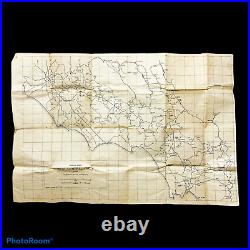
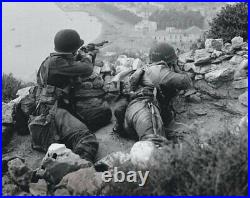
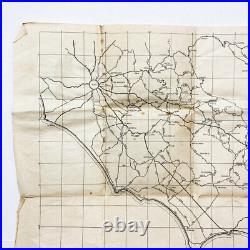
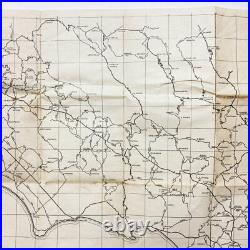
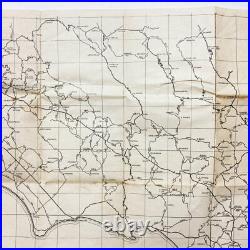
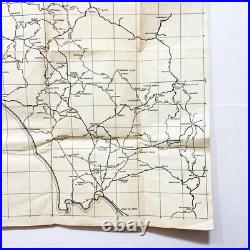
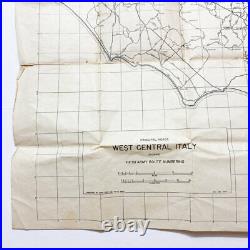
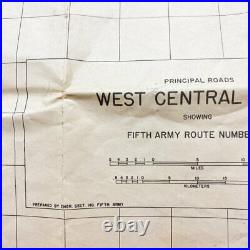
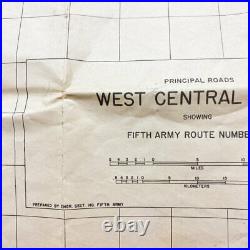
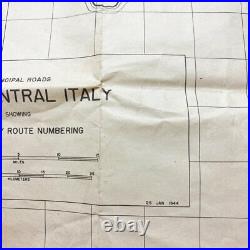

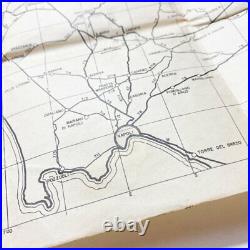


Size: 21.5 x 14.5 inches. Prepared by the Engineer Section of the 5th Army, this map was carried by combat infantry soldiers, tank crews, etc as they fought extensively in the Italian campaign having fought in some of the most well known WWII combat operations including Operations Husky, Operations Avalanche, and Operations Shingle. We believe this to be a'field printed' map as it shows the'Principal Roads of West Central Italy' and the'5th Army Route Numbers'. The map itself is dated January 25th of 1944, 3 days following the VI Corps landed at Anzio, unopposed on the 22nd of January 1944 in Operation Shingle.
This map shows an extensive amount of use and wear and would have been heavily used as the 5th Army pushed through the bloody battles of the Volturno Line, Barbara Line and the Gustav Line. 5th Army in Italy during WWII. The Fifth Army first saw action during the Salerno landings (Operation Avalanche), the assault landings at Salerno, part of the Allied invasion of Italy, in September 1943. Due to the comparatively low numbers of American troops available in the Mediterranean Theater it was made up of one American and one British corps. VI Corps, under Major General Ernest J. Dawley and the British X Corps, under Lieutenant-General Richard L. At Salerno, VI Corps landed on the right flank, and X Corps on the left flank. Progress was initially slow, due in part to a lack of initiative by Dawley, the VI Corps commander, and due also to heavier than expected German resistance.
However, heavy naval and air bombardment, along with a parachute drop by elements of the U. 82nd Airborne Division, had saved the forces from any danger of being driven back into the sea, combined with the approach of the British Eighth Army, under General Bernard Montgomery (the Eighth Army had landed further south in Operation Baytown, six days before Avalanche), the German 10th Army began to retreat. On 20 September, by which time the Fifth and Eighth Armies had linked up, Major General Dawley, VI Corps commander, was relieved of his command by Clark. Dawley was temporarily made deputy army commander, and was soon replaced in command of VI Corps by Major General John P.
Progress was then good for a couple of weeks and the Fifth Army crossed the Barbara Line and the Volturno Line until the Germans turned, stood and fought. They had established a position on the Winter Line (also known as the Gustav Line), which included the formidable defensive positions at San Pietro Infine in the Liri Valley and at Monte Cassino. By this point, Fifth Army had been reinforced by a second American corps, II Corps, commanded by Major General Geoffrey Keyes. By the end of November Clark's Fifth Army had almost doubled in size, with the addition of French General Alphonse Juin's French Expeditionary Corps, from 130,247 men to 243,827. With the failure of the first operations to capture Monte Cassino, an attempt was made to exploit the Allied preponderance in seapower before the coming invasion of Normandy robbed the Mediterranean of the naval forces necessary for an amphibious assault to seize Rome.
Generalfeldmarschall (Field marshall) Albert Kesselring-German commander-in-chief Italy- ordered his forces to retreat to the Barbara Line on 12 October 1943 after the U. Fifth Army crossed the Volturno River, breaching the Volturno defensive line. By early November the Barbara Line on the Tyrrhenian Sea side of the Apennine Mountains had been breached by the U. Fifth Army, and the German Forces fell back to the Bernhardt Line. 5th Army Operation on the Volturno River. As a response to the increasing Allied pressure on the Adriatic front, on October 1st the German supreme commander in Italy-Generalfeldmarshall Albert Kesselring-ordered the 16th Panzer Division to switch to the Adriatic front. Elements of the British 78th Infantry Division's 11th Brigade infantry crossed the Biferno at dawn on 3 October 1943 following an amphibious landing at Termoli by British Commandos at 02:15. By late morning, the two elements had linked up and that night 78th Division's 36th Brigade were able to be landed by sea at Termoli.
However, logistical problems had prevented the Allies building a heavy duty bridge across the Biferno and when the bulldozed fords were made unusable after 5 tanks had crossed, there was no way to get more tanks across the river to support the infantry. A lighter weight FBE bridge was built to allow artillery, recconnaissance, and other vehicles to cross. The move east of 16th Panzer Division presented a major and unforeseen threat to the unsupported Allied infantry.
As news of the German armour's arrival came in on 4 October, 78th Division's commander- Major-General Vyvyan Evelegh-demanded priority from British Eighth Army, under General Bernard Montgomery, for bridging equipment. As more German armour arrived, the Allied troops across the Biferno were forced onto the defensive. By the afternoon of 5 October, they had been squeezed back to within.
5 mi (0.80 km) of Termoli. However, at the same time frantic round the clock efforts by engineers had resulted in a heavyweight Bailey bridge being completed allowing Canadian and British armour across the Biferno. That evening, 78th Division's 38th (Irish) Brigade arrived by sea at Termoli and the German attack the following morning was narrowly repulsed in desperate fighting. By late morning on 6 October, the Allies were on the attack and by late afternoon the Germans had started to fall back to the next prepared defences on the River Trigno, the Barbara Line.

